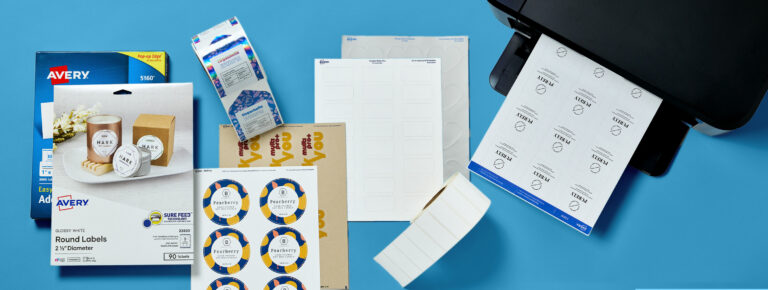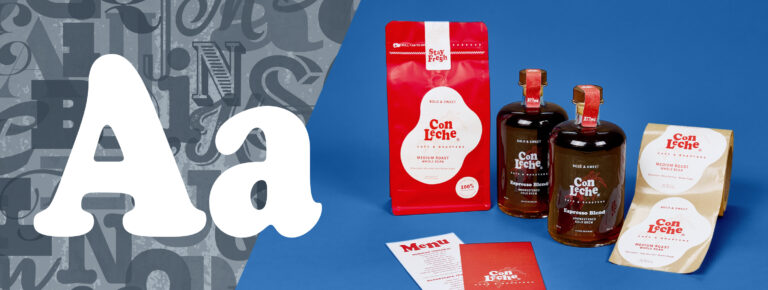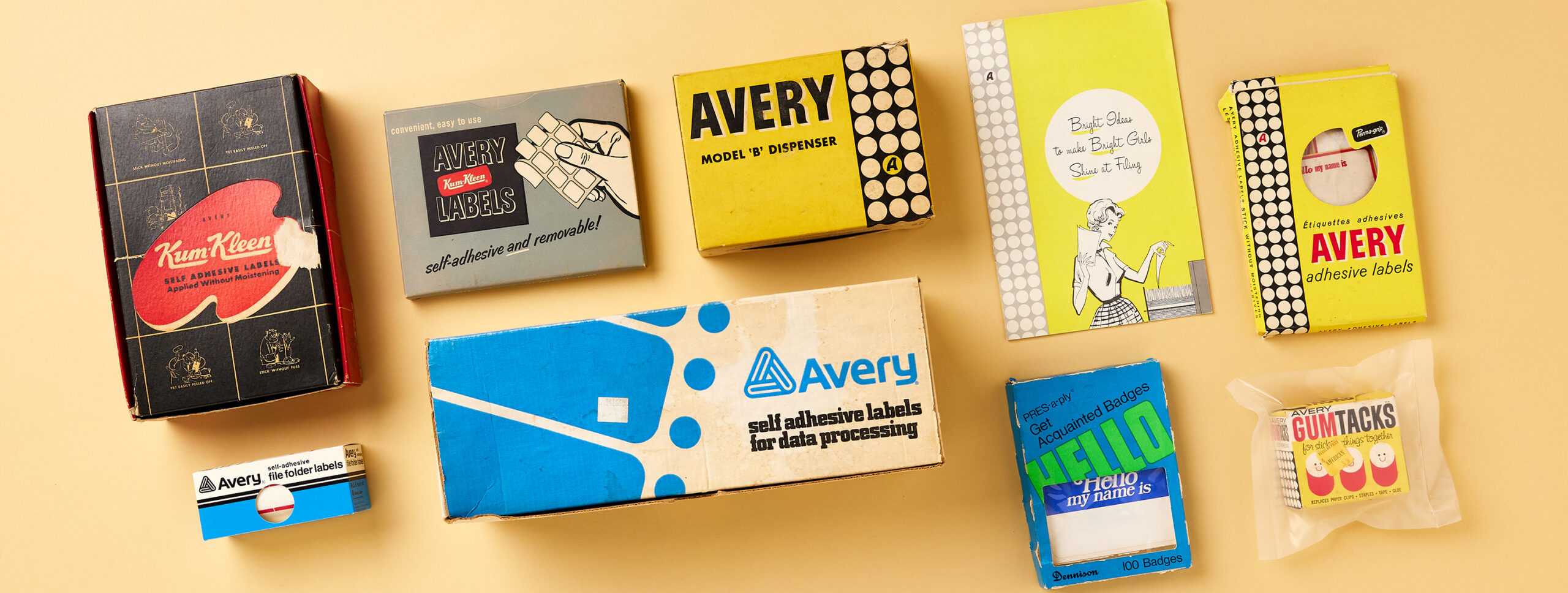
The Amazing History of Labels: When Were Stickers Invented?
Avery labels come with a legacy that reaches back nine decades to the invention of stickers. In fact, in the history of labels, Avery is a name that’s hard to miss. The brand stands out for its quality, availability at national retailers, and a reliable alternative to trendy sticker companies. And if you’ve gone back-to-school shopping or worked in an office in the past 30 years, you’ve likely used Avery products—even if you didn’t know it!
My personal history with Avery goes back to when I was 12. My mom ran a small courier service in Diamond Bar, CA. Ever the resourceful businesswoman, she would send a courier to pick me up after school, using our secret family safety code. So I spent my afternoons at her office, doing a combination of homework and odd jobs. This often included printing address labels and addressing envelopes using Avery 5160 pin-fed address labels. Yes, I was in middle school during the ancient days when pin-fed printers were cutting edge.
Fast forward 27 years to 2019, preparing for an interview at Avery Products Corporation. I knew about Avery labels, but not much about their office supplies. While shopping for interview folders, I chose a black, cream, and gold set that looked professional but still felt stylish enough to complement my creative personality. Only later did I realize they were Avery folders, completing my full-circle moment with the most famous name in the history of stickers.
When were stickers invented?
Ray Stanton Avery (R. Stanton Avery), who generally went by Stan, invented the first self-adhesive labels (or what he would soon market as stickers) in 1935. Although Stan Avery invented stickers in 1935, he actually didn’t start selling them until 1940 as the product “Kum Kleen Price Stickers.” In the same year, he obtained patent US-2220071-A for a “method and apparatus for making label units.” In 1942, he obtained patent US-2304787-A for a non-drying adhesive label and the method for making it. Want to learn more about stickers? Read about the difference between modern-day stickers and labels.
A sticker by any other name…
What is a sticker? Merriam-Webster defines stickers as slips of paper with adhesive backs that a person can fasten to a surface. Throughout the history of stickers, people have often used the terms sticker, label, and decal interchangeably to describe any material with a sticky back. While experts today distinguish between stickers and labels based on their specific uses, the basic dictionary definition remains accurate.
What “decal” means
In the history of stickers, the term “decal” has developed a more complex meaning, closely tied to how they are applied to surfaces. When you think about using a label or sticker, you probably picture peeling it off a backing sheet and pressing it sticky side down onto a surface. Sometimes durable stickers are referred to as decals and are applied this way. However, often times the term “decal” indicates a different type of application (i.e., you transfer them from one surface to another using heat, water, or adhesive). For example, you transfer temporary tattoos with water, and fabric transfers with heat. Vinyl letters for walls are another common type of decal people use in everyday life. This video demonstrates the application of vinyl decals, and you can see how it differs from simply using a sticker or label.
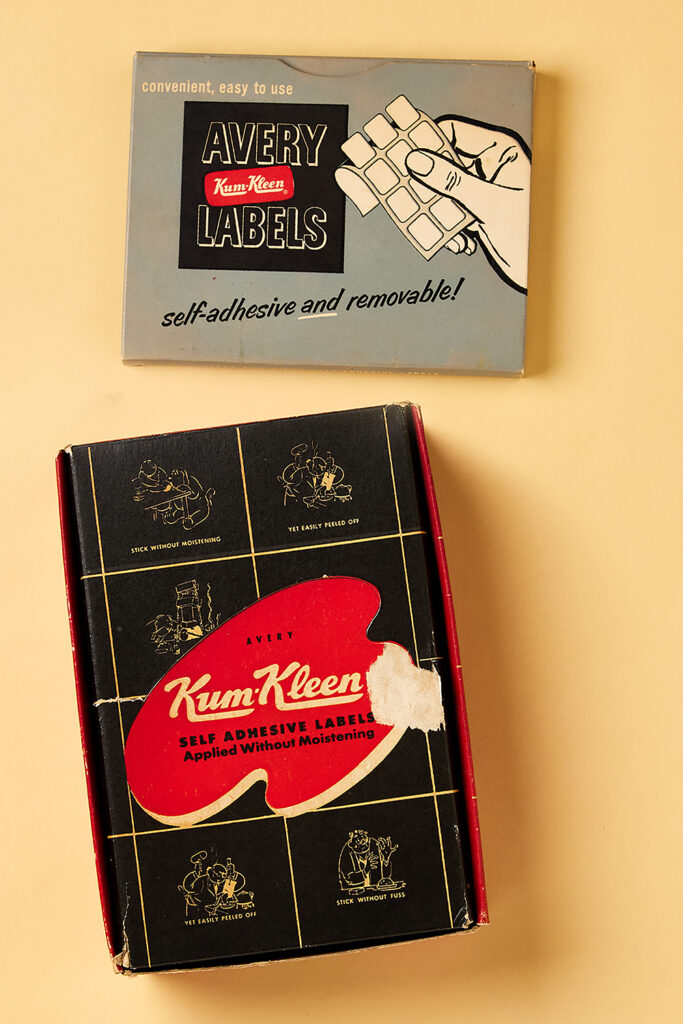
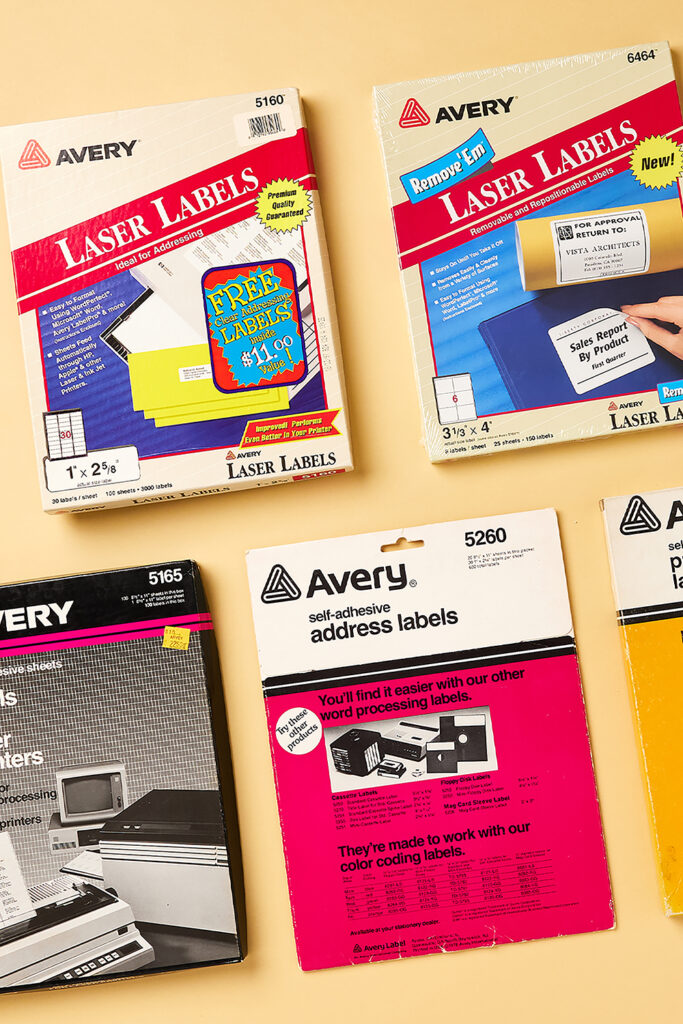
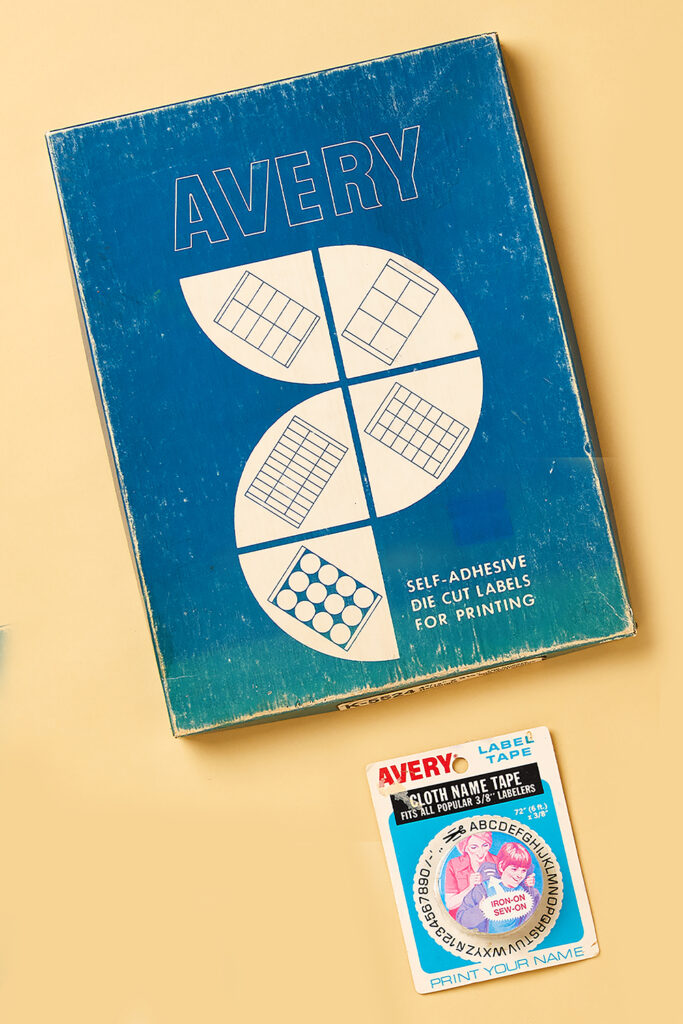
The history of labeling and how stickers changed it all
At our core, humans like to sort and categorize things. In fact, it helps us find patterns, predict behaviors, and better understand the world around us in general. So naturally, humans have been labeling stuff pretty much since we’ve had stuff to label. Although before stickers, it usually involved tying various pieces of paper, cloth, wood, ivory, or bone to an object. Today, there are hundreds of ways self-adhesive stickers have made labeling easier and more efficient. They’re used for everything from putting price tags and ingredient lists on products to organizing file folders and finding books at the library.
With that in mind, let’s take a look at the earliest ways humans labeled objects. Then we’ll explore how modern stickers have made it so easy that even twelve-year-old kids can easily address business envelopes.
History of stickers & labels infographic
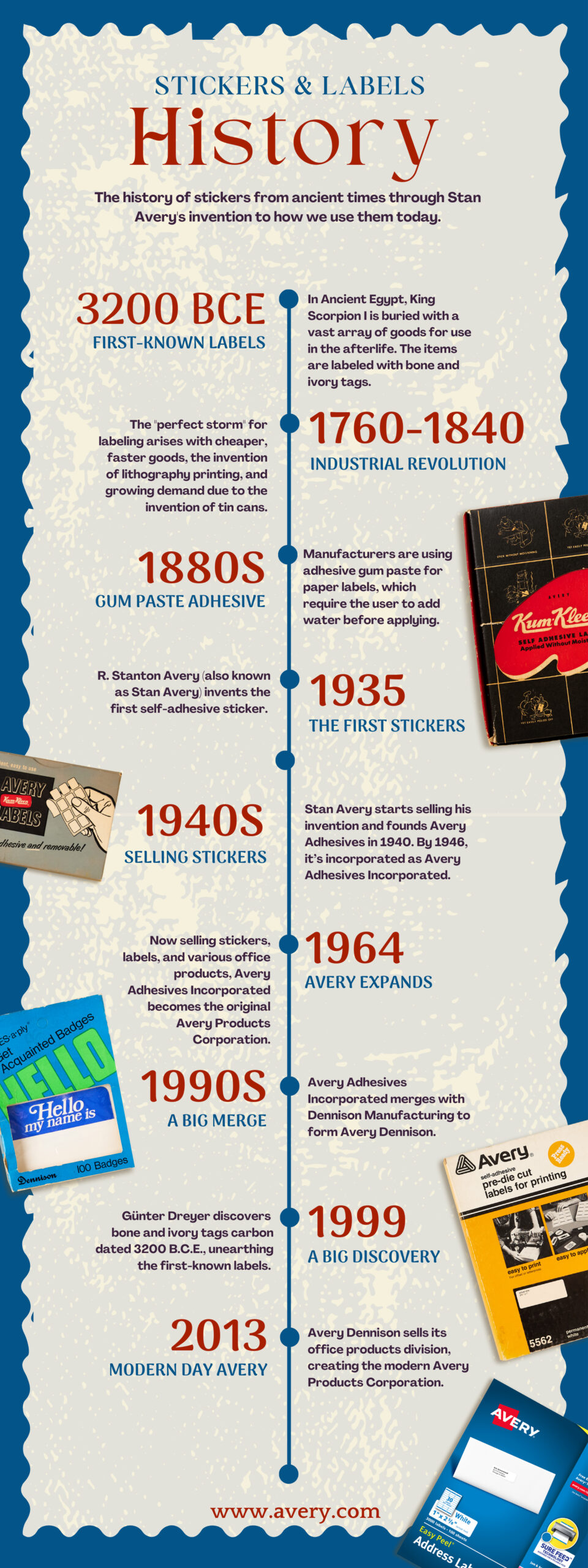
Earliest labeling history
The history of labeling goes all the way back to ancient Egypt to the time of King Scorpion I, around 3150 BCE, at least as far as we can tell. We have this touchstone in time because of discoveries made by archeologist Günter Dreyer at Abydos in 1999. Dreyer uncovered bone and ivory tags dating back to 3200 B.C. Originally attached to boxes or containers, these tags detailed the product quantity and origin. They included the names of places and organizations that were part of trading goods like grain and fabrics. This find marks the earliest known use of writing for labeling and identification in history.
Just add water: paper labels in the 1800s
The Industrial Revolution (roughly 1760–1840) made more goods available to more people, and they could get them cheaper and faster than ever before. Then, in 1810, Peter Durand also patented tin cans for food. The rapid increase in goods, combined with the challenge of labeling sealed, opaque cans, led to a revolution in the history of stickers and labels too. Luckily, the relatively new invention of lithography (1796) provided a clean, accurate printing solution. By the 1880s, manufacturers were using various adhesive gum pastes to stick paper labels directly onto cans, bottles, and jars. The only catch? You had to moisten the labels with water to make them stick.
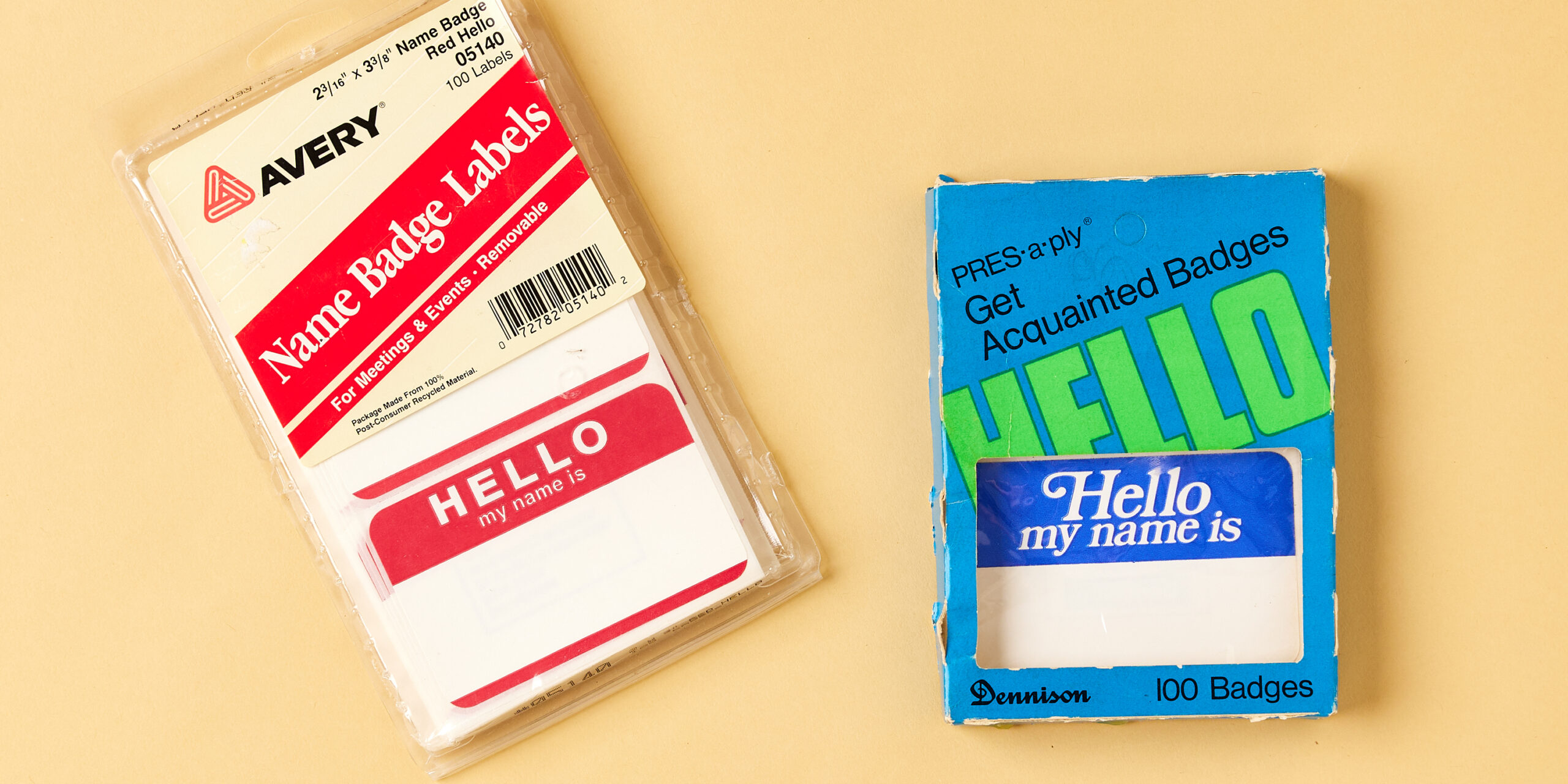
R. Stanton Avery: The beginning of modern sticker history
The history of Avery stickers is a story of innovation that changed the way we label and organize. When Stan Avery invented the first self-adhesive stickers in 1935, it completely changed the labeling game for everyone. From giant manufacturers and small businesses labeling products to the average person organizing their home or workspace, labeling became more efficient. People no longer needed a separate way to moisten labels. Avery went on to form Avery Adhesives, located in downtown Los Angeles. When he started selling his invention in 1940, people used the first stickers to put prices on goods and products.
Over the next three decades, Avery Adhesives continued to expand, incorporating in 1946 and changing the name to Avery Products Corporation in 1964. As the company grew, it became an integral part of the history of stickers and labeling. In the 1990s, the original Avery Products Corporation merged with Dennison Manufacturing to form Avery Dennison. Then, in 2013, Avery Dennison made a strategic decision to focus on its core strengths, leading to the sale of its office products division. This created the modern Avery Products Corporation, where we’re dedicated to providing high-quality labeling and organizational solutions. Today, Avery Products Corporation is headquartered in Brea, CA, about 35 miles from the original Avery Adhesives location in downtown LA. We continue to build on Stan Avery’s rich legacy, offering a wide range of labels, stickers, and office supplies that help people stay organized, whether at home, school, or work.
How stickers are made today
Stickers are typically made with three main components: facestock, adhesive, and release paper.
- Facestock is the part of the sticker you see and can be a variety of materials, including paper, vinyl, and clear, white, holographic, and metallic films.
- Adhesive is generally on the back of the sticker and is what makes it stick. It can be permanent, removable, or repositionable.
- Release paper is the slick, shiny sheet that you peel off stickers before use. Wax paper, acetate, and paper coated with silicone polymers are all examples of release papers for stickers.
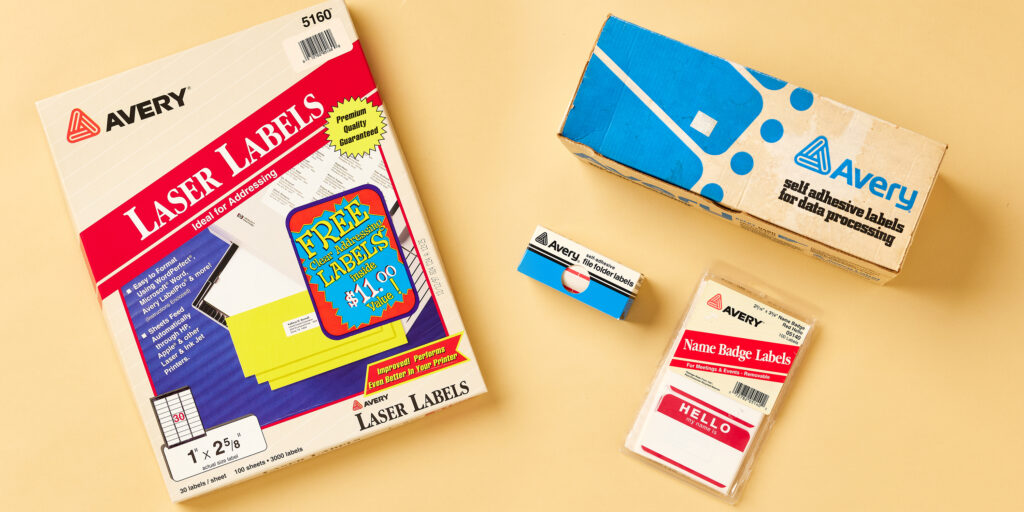
Sticker and labeling evolution in the 21st century
We’ve come a long way since Stan Avery patented the first sticker-making apparatus in 1942, marking a significant moment in the history of stickers. What used to be a simple tool has now become a versatile and accessible option for everyone, whether you’re labeling products, decorating, or organizing. With the rise in printing options and the sheer variety of stickers available, there’s something out there for every need and style.
What’s more, 90 years of innovations in materials and label printing techniques have made the stickers and labels of today more advanced than ever. You’ll find everything from durable waterproof films and removable stickers to repositionable, block-out, and even holographic options.
At Avery, we continue to pioneer these changes. In 2014, we launched our custom printing business as a direct-to-consumer platform, allowing customers to create and order custom labels with ease. Then in 2018, we introduced blank label sheets available for online orders with no minimums or set quantities, giving customers even more flexibility and convenience. Today, we offer high-quality stickers and labels that make life easier and more organized for everyone. Whether you’re starting a small business, labeling your pantry, or managing your time with planner stickers, there’s a sticker just right for you. And of course, you can still quickly and easily address envelopes with the iconic Avery 5160 address label.
Types of stickers
Stickers come in all kinds of shapes, sizes, materials, and finishes. However, these are the top 10 most common types of stickers:
- Custom Stickers: Fully customizable stickers that are perfect for branding, promotions, and personalized gifts.
- Round Stickers: Available in various sizes, these circular stickers are ideal for seals, logos, and decorative purposes.
- Square and Rectangular Stickers: These are versatile stickers you can use for labeling products, gift tags, or address labels.
- Glossy Stickers: Designed to stand out with a shiny finish, these stickers commonly serve as marketing materials, product packaging, and event promotions.
- Glossy Clear Stickers: Transparent stickers blend seamlessly with the surface, creating a clean, professional look. People often use them for branding, packaging, and sleek product labels.
- Matte Stickers: With a smooth, non-reflective finish, matte stickers offer a more understated, elegant look. People commonly use them for labeling, scrapbooking, and other creative projects.
- Removable Stickers: Designed for easy removal without residue, these stickers are perfect for temporary labeling, promotions, or projects requiring reusability.
- Waterproof Stickers: Made to withstand moisture and outdoor conditions, these durable stickers ideally label items exposed to water or harsh environments, such as bottles, outdoor equipment, or gardening tools.
- Planner Stickers: Fun, colorful stickers designed specifically for use with a personal planner or bullet journal to manage time.
- Label Stickers: Stickers specifically designed for labeling purposes, such as organizing storage containers, jars, or office supplies. They come in various shapes and sizes to suit different labeling needs.
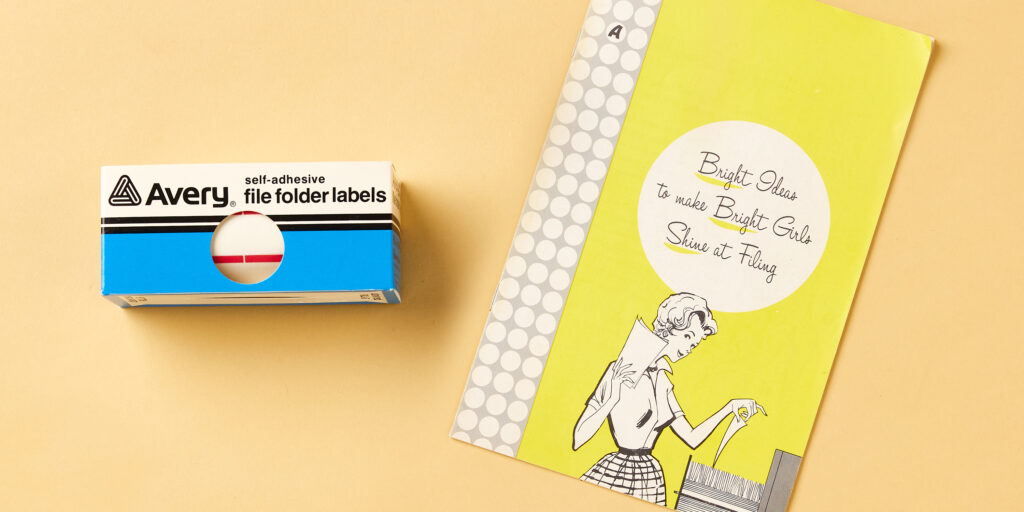
Cultural impact of stickers and labels
Stickers and labels are such a versatile and fun part of our lives, whether we realize it or not. They’ve certainly been a huge part of my life since my mom introduced me to address labels in the 90s. I saw firsthand how they helped her small business send professional mail more efficiently. Labels also help office professionals stay organized. They make it easy to identify and manage everything from documents to supplies. For small and medium-sized businesses, stickers can be a real game-changer as well. They add a professional touch to branding and packaging that makes a big impact.
And let’s not forget the joy stickers bring in everyday life—think of the memorable bumper stickers you’ve seen. Or maybe stickers you collected as a kid and traded or displayed with pride. Then there’s the classic “Hello, my name is…” name tags that we’ve all used at events. They’re a simple yet powerful way to connect with others. Did you know that the iconic Avery “Hello, my name is…” stickers have even made their way into pop culture? They’ve shown up on many of our favorite TV shows and were referenced in a song by Eminem.
The amazing history of stickers, labels, and all of us
When Stan Avery invented stickers almost 100 years ago, did he know how big his place in the history of stickers would be? I truly don’t know, but what I do know is that stickers and labels are more than just a tool—even for my mom just addressing envelopes in the 90s. For her, like many business owners before and after, they were a way to make her business look professional and stay organized. Regardless, Stan Avery’s legacy reaches down to us to this day through Avery products that continue to provide solutions with the same dedication that started it all. From helping small businesses create a polished image to offering simple tools for everyday organization, modern Avery products have become an integral part of both professional and personal life.
What is your favorite memory of using stickers or labels? Share with us on TikTok, join the conversation on Facebook, or share your projects using #avery products on Instagram.


